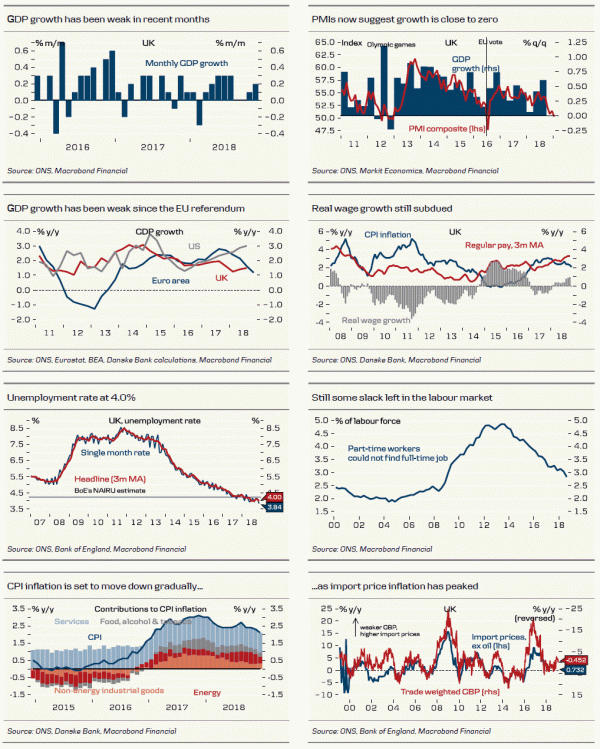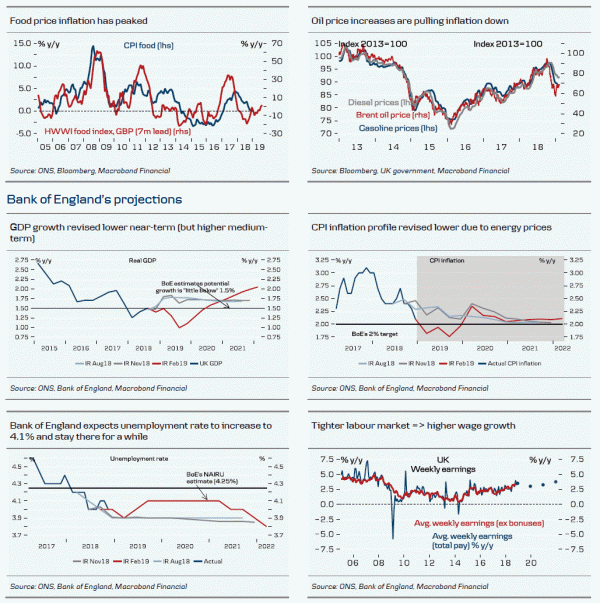As expected, the Bank of England (BoE) voted unanimously to keep the Bank Rate at 0.75%. As expected, it lowered both its GDP and CPI inflation projections.
The Bank of England did not make any big policy signal shifts either. The statement still says that ‘an ongoing tightening of monetary policy over the forecast period, at a gradual pace and to a limited extent, would be appropriate…’, i.e. still a hiking bias despite recognising growth has slowed both globally and in the UK. The reason is that the Bank of England still projects excess demand of 0.75% of GDP in three years.
Last month, we changed our BoE call and now we expect it to be on hold until November (previously May). Markets are less certain and do not price in any action from the BoE in the near future. Near term, the case for a rate hike has diminished, with weaker economic data and high Brexit uncertainty and, in our view, it is difficult for markets to start pricing further BoE rate hikes until we get some Brexit clarification.
However, the next hike may come earlier if we actually get some clarification soon. As Mark Carney highlighted during the press conference, growth may surprise on the upside after Brexit clarification, as companies could restart investments plans that have been postponed due to Brexit uncertainties. If this materialises soon, the hike could still come earlier. This also highlights that markets are in a hole right now.
In case of a no-deal Brexit (which is definitely not our base case), we expect the Bank of England to ease monetary policy. While the Bank of England cannot offset lower potential growth due to changes in the supply side of the economy, it can react to demand changes. Our view is that a ‘no-deal Brexit’ would be likely to hit the economy through lower demand due to lower business confidence.
For our latest take on Brexit, see Brexit Monitor – May has two and half weeks to renegotiate the backstop, 29 January. Based on recent developments, PM Theresa May and the EU27 plan to meet again in late February and the next ‘meaningful vote’ has been postponed. Next week, on 14 February, the UK House of Commons is due to vote on a statement from PM Theresa May (which is amendable), giving MPs another chance to tell her what they want (including voting for a possible extension of Article 50).
The GBP quickly recovered from the initial knee-jerk sell-off following the BoE announcement and continued rallying during the press conference, as BoE Governor Mark Carney said that markets should not prepare for no further rate hikes in the UK. We still expect the BoE to hike in November 2019, while the market is pricing in the next hike arriving in June 2021. Hence, higher UK interest should be a supporting factor for GBP over the medium term.
However, in the short term, Brexit remains a key driver for the GBP. We still look for EUR/GBP to remain in the 0.86-0.89 range. We maintain the view that it would require a further reduction in the ‘no deal’ Brexit risk for EUR/GBP to test and eventually break below 0.86, while appetite for GBP is likely to deteriorate as 26 February approaches without any signs of an agreement between the EU and UK.
















